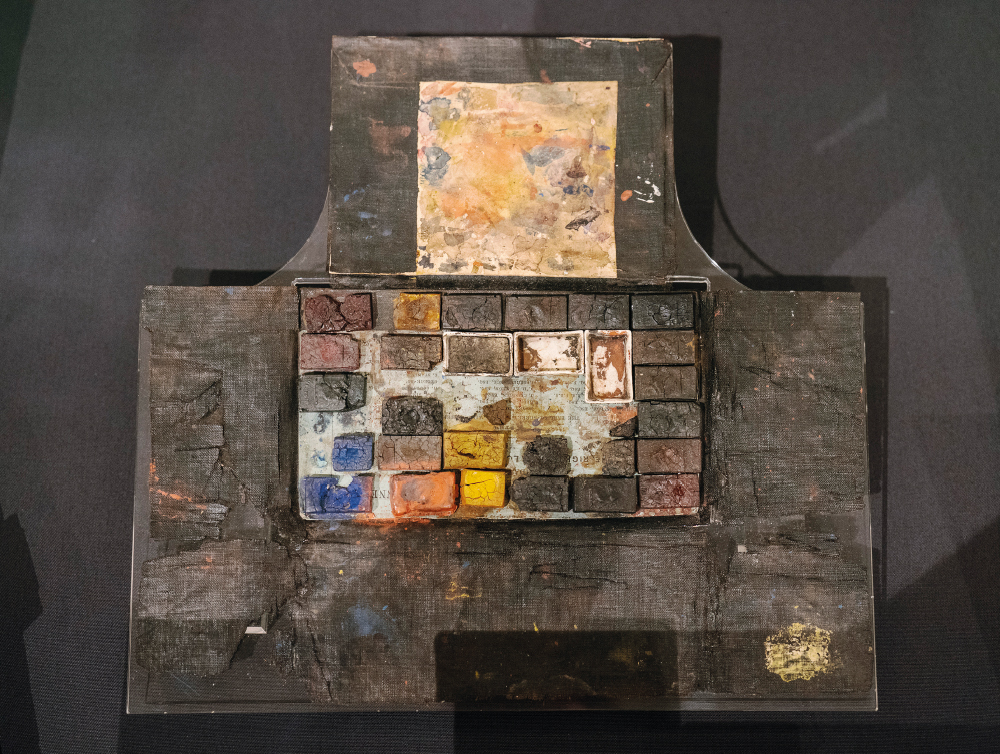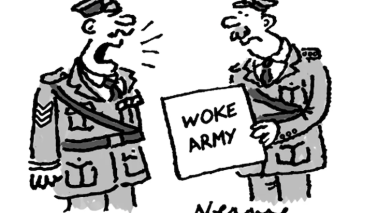
History is full of odd couples: famous but unrelated people who happen to have been born in the same year. 1809: Charles Darwin and Abraham Lincoln. 1926: Queen Elizabeth II and Marilyn Monroe. Yet few historical pairings are as unlikely as the novelist Jane Austen and the painter J.M.W. Turner, born within a few months of each other in 1775.
Usually the only time these two cultural icons encounter one another is in our purses or wallets: Turner depicted as a dashing young Romantic on the £20 note, Austen looking demure and doe-eyed (a heavily airbrushed version of the portrait originally sketched by her sister Cassandra) on the £10 note. Otherwise they might appear to have little in common. Turner painted large-scale canvases that were full of visual drama and danger; Austen joked that her intimate domestic scenes were written on a ‘little bit (two inches wide) of Ivory’. Turner lived with his lover and dabbled in erotic drawings; Austen lived with her mother and told Cassandra: ‘You know how interesting the purchase of a sponge-cake is to me.’ Turner displayed his paintings in a London gallery built to his own specifications; Austen wrote in a house with a creaking door that allowed her to hide her work under a piece of blotting paper whenever she heard someone coming.
Yet although they probably never met, a new exhibition that opened earlier this month in Harewood House – the Yorkshire stately home where the 2019 film Downton Abbey was shot – aims to put them in conversation with each other. It’s where Turner was commissioned in 1797 to produce a set of watercolours showing Viscount Lascelles’s grand new house with grounds laid out by Lancelot ‘Capability’ Brown, like a Regency version of boastful Instagram posts. As an up-and-coming young artist, Turner was paid just ten guineas per painting, and although he was highly effective at cultivating such well-heeled patrons, later watercolours such as ‘The Drawing Room, Farnley Hall’ (1818), which shows a room so large the people it contains are little more than dots in the distance, suggest that even after he found himself at the heart of the British establishment he continued to think of himself as something of an outsider.
Austen was similarly caught between two worlds. At the age of 16, her brother Edward was adopted by a wealthy distant cousin, so she often spent periods living as a guest in other grand country houses, part of the household but also inevitably set apart from it. Her response was to develop a narrative voice that allowed readers intimate access into someone else’s life while simultaneously keeping it at an ironic distance. Like Fanny Price in Mansfield Park, who sits so quietly on the sofa in her rich uncle’s drawing room that nobody even realises she’s there, Austen too learned how to hide in plain sight.
More importantly, both Turner and Austen knew what was concealed behind the elegant façades of these houses. The Lascelles fortune came partly from Caribbean sugar plantations, and although the British slave trade was outlawed in 1807, it continued for many more years overseas. Two of Austen’s brothers were naval officers whose duties included patrolling the oceans in search of slave ships, so it’s probably no coincidence that ‘Lady Lascelles’ is the name of a peripheral character in Mansfield Park, working like a wink to readers who were in on this particular joke.

The real Lascelles family certainly didn’t seem ashamed of their connection with the novel. Indeed, they owned an expensively bound first edition, although it’s hard to know how they would have responded to the moment when Fanny asks her uncle about the slave trade and is met with ‘a dead silence’. Whether this silence is born out of embarrassment or annoyance, it reverberates throughout the rest of Mansfield Park. When Fanny drinks her tea, or chooses a new gold necklace from a box lined in cotton, Austen is quietly reminding us that such social refinements were often rooted in hidden human misery. In this exhibition, the Harewood copy of her novel is set alongside a reproduction of Turner’s 1840 painting ‘The Slave Ship’, depicting slaves who have been thrown overboard into a stormy sea, where a tangle of limbs pokes out of the water like the debris of a shipwreck, and so confronts the viewer with everything that is quietly bubbling away under the surface of Austen’s writing.
Although they never met, a new exhibition puts Austen and Turner in conversation with each other
Austen herself died more than two decades before Turner’s painting was exhibited, but she might have seen some of his earlier landscapes and seascapes on one of her occasional trips to London. In 1813 she wrote excitedly to Cassandra about visiting the Royal Academy summer show at Somerset House, where Turner was the Professor of Perspective, confessing that she had ‘great amusement among the Pictures’ trying to find a portrait of Mrs Darcy, one of the romantic leads in her recently published novel Pride and Prejudice. Many of her other characters are equally interested in art. Emma Woodhouse makes ‘various attempts at portraits’ in Emma together with ‘specimens of… landscapes and flowers’, while in Sense and Sensibility Marianne Dashwood has a fashionable love of the picturesque, which Austen gently mocks by showing us what a poor grasp of perspective her heroine has in other areas of her life.
In 1804 Austen also sat for a second watercolour by Cassandra, which shows her from the back (all we see of her face is the curve of a pink cheek) wearing a blue bonnet and calmly gazing out into a blank space. At first glance it looks very different from the type of art that Turner was starting to develop, by creating thick whorls and smears of paint to show his excited engagement with everything from erupting volcanoes to snow storms. Yet in some ways Austen and Turner were surprisingly alike.
Both were drawn to Romantic wildness, as we see in the white-flecked waves of the watercolours that Turner painted in Lyme Regis, and in Austen’s descriptions of the same place in Persuasion, where the ocean’s ‘grandeur’ is judged to be far more exciting than rainy Bath. Not everyone agrees, and in her unfinished last novel Sanditon, set in another seaside resort, Austen describes several characters ignoring ‘a beautiful view of the Sea’ through a firmly closed window. But Austen herself seems to have been increasingly drawn to the coast as a place where the ground shifted beneath your feet and civilisation fell away into savagery. That’s probably because it chimed so well with her own literary interests. Her teenage writings had been packed with cartoonish anarchy, and although her adult novels might at first appear far calmer, they are just as playfully subversive. Often her fiction contains her ideas only in the way that someone might try to contain a fire or a riot.
There was always a chance that visitors to the Royal Academy might spot Turner himself pacing through its galleries, diminutive and top-hatted, although if he and Austen did ever meet it’s hard to imagine what they would have said to each other. Turner was gruff and socially awkward, Austen far more precise and playful. But on their shared 250th birthday it’s right that we should celebrate them together. Both were innovators: Turner created a new style of painting, while Austen created a new kind of novel. (The Oxford English Dictionary also records her as the first person to use dozens of common words and phrases in her writing, including ‘shut up’, ‘outsider’, ‘door-bell’, ‘stylishness’, and ‘terrace house’.) Turner changed how we perceive the natural environment; Austen changed how we understand each other. Both did what Shelley thought was poetry’s job, namely to ‘strip the veil of familiarity from the world’ and make us think again about everything we thought we knew.
Austen and Turner: A Country House Encounter is at Harewood House until 19 October. Jane Austen: Down to the Sea is at the Dorset Museum and Art Gallery from 14 June until 14 September.








Comments